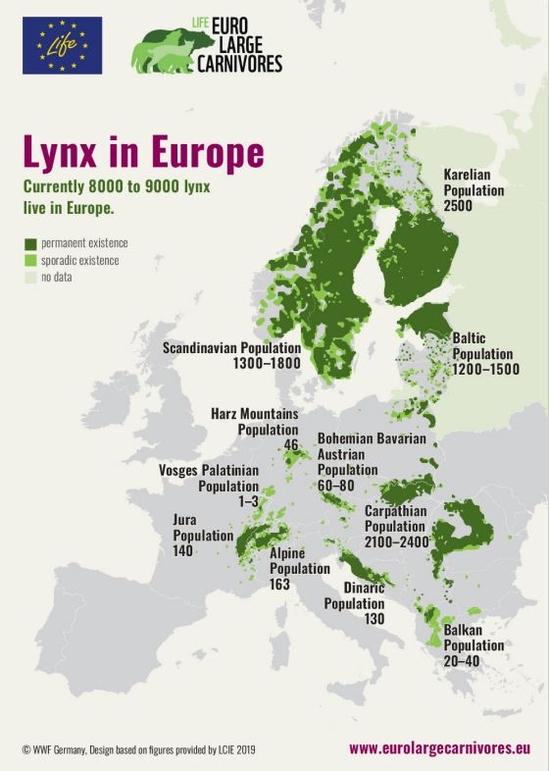Lynx Distribution Map in Europe


David Chen
Data Visualization Specialist
David Chen is an expert in transforming complex geographic datasets into compelling visual narratives. He combines his background in computer science ...
Geographic Analysis
What This Map Shows
The "Lynx in Europe" map provides a detailed visualization of the distribution and habitat of the lynx species across the European continent. From the dense forests of Scandinavia to the mountainous regions of the Alps, this map highlights the specific areas where different lynx populations reside, alongside their conservation statuses and habitat requirements. It serves as a crucial tool for understanding not just where these elusive creatures roam, but also the ecological dynamics that influence their populations.
Deep Dive into Lynx Populations
Lynx, particularly the Eurasian lynx (Lynx lynx), are fascinating felines known for their tufted ears, short tails, and stunning spotted coats. These solitary and elusive animals thrive in various habitats, from boreal forests to rugged mountain terrain. What’s fascinating is that lynx play a critical role as apex predators in maintaining the health of their ecosystems. Their primary diet consists of small to medium-sized ungulates like roe deer and hares, which means their hunting patterns can significantly impact prey populations and vegetation dynamics.
Interestingly, the lynx's adaptability to different environments is remarkable. In the north, they thrive in the coniferous forests of Scandinavia, where snow cover is deep enough to help them hunt. Conversely, in central and southern Europe, their habitats can vary significantly due to human encroachment and landscape changes. As a result, lynx populations have been affected by various factors, including habitat fragmentation and reduced prey availability.
According to the latest data, the Eurasian lynx is found in multiple European countries, including Norway, Sweden, Finland, Estonia, and parts of Poland and the Czech Republic. The populations in these regions have shown varying trends, often influenced by conservation efforts. For instance, in the Scandinavian countries, proactive wildlife management has led to a stable increase in lynx populations, while in other areas, such as the Alps, they face challenges due to habitat loss and hunting pressures.
Current estimates suggest that there are approximately 7,000 to 10,000 individuals across Europe, though numbers can vary widely by region. In some areas, like the Carpathians, lynx populations are stable or increasing thanks to conservation programs, while in western Europe, they remain at risk. Efforts to monitor and manage their populations are vital, especially as they are classified as a species of Least Concern by the IUCN, but they still face threats from habitat loss and climate change.
Regional Analysis
When examining the map more closely, distinct regional patterns emerge. In Scandinavia, particularly Sweden and Norway, the lynx population is relatively robust, supported by extensive forest cover and prey availability. In contrast, the distribution of lynx in southern Europe, such as in Italy and the Balkans, is more fragmented due to urbanization and agricultural expansion.
In the Alps, lynx populations have been bolstered through reintroduction programs, demonstrating a successful conservation strategy. However, these populations are still vulnerable to poaching and habitat loss, leading to ongoing monitoring efforts. For example, in Switzerland, lynx sightings have become more common, thanks to a combination of protected areas and public awareness campaigns. Meanwhile, in Eastern Europe, countries like Romania and Slovakia have stable populations, but they still require careful management practices to mitigate human-wildlife conflict.
Significance and Impact
Why does the distribution of lynx in Europe matter? These animals are indicators of a healthy ecosystem. Their presence signifies a balanced environment where prey populations are managed naturally. Moreover, lynx have significant cultural value in many European countries, often symbolizing wilderness and conservation.
As human activities continue to encroach upon wildlife habitats, understanding lynx distribution is crucial for effective conservation strategies. With climate change posing additional threats to their habitats, ongoing research and monitoring are essential. Future projections indicate that lynx populations may shift northward as temperatures rise, which could further impact prey dynamics and ecosystem health. The conservation of the lynx not only helps preserve this iconic species but also supports the broader ecological integrity of European landscapes.
In conclusion, the lynx distribution map serves as a vital tool for understanding the status and needs of this magnificent species. Through careful conservation efforts and public engagement, we can ensure that the lynx continues to roam the forests of Europe for generations to come.
Visualization Details
- Published
- August 12, 2025
- Views
- 126
Comments
Loading comments...